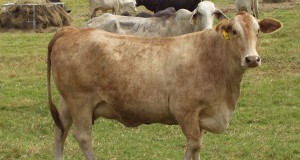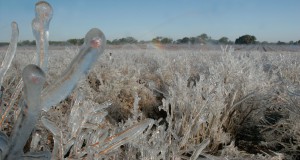
In Florida, early-ripening southern highbush blueberry cultivars allow growers to take advantage of high prices in the early market before other states can compete with higher volumes of berries sold at lower prices. That advantage comes with a vulnerability, however, because frosts can reduce gains. Florida growers rely on strategies like cold protection irrigation to reduce their risk of loss due to cold damage. This 9-page article by Tatiana Borisova, Tori Bradley, Mercy Olmstead, and Jeffrey Williamson describes a UF/IFAS study comparing precision cold protection irrigation to uniform cold protection irrigation to estimate the potential savings in diesel costs and water withdrawal volumes associated with the two practices and help protect Florida’s valuable and vulnerable blueberry harvest. Published by the Food and Resource Economics Department in November 2015.
http://edis.ifas.ufl.edu/fe979
Category: Agriculture
The Social Organization of Honey Bees
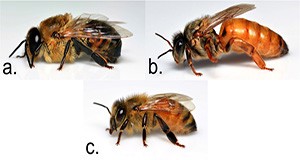
A honey bee colony is a superorganism, which means that together its members function like a single animal. Bees within a colony work together like the cells in a human body. They warm the colony in the winter by vibrating their wings to generate heat and cool it in the summer by ferrying in droplets of water and fanning air over them. Worker bees fan air into and out of the colony entrance in distinct inhalations and exhalations. Colonies reproduce by swarming to create new daughter colonies that in turn thermoregulate, breathe, and reproduce just as a single autonomous animal does. In three pages this fact sheet explains the intricate caste system and age-based division of labor that allows colonies of humankind’s best-loved pollinators to function and thrive. Written by Ashley N. Mortensen, Bryan Smith, and James D. Ellis and published by the Entomology and Nematology Department.
http://edis.ifas.ufl.edu/in1102
New Featured Creature publications added
The following publications are now available in EDIS:
Released November 9:
- Spicebush Swallowtail Papilio (Pterourus) Troilus Linnaeus 1758
- Lesser Wax Moth Achroia grisella Fabricius
- Oblong-Winged Katydid (suggested common name) Amblycorypha oblongifolia
- Florida Flower Thrips (suggested common name) Frankliniella bispinosa Morgan
- Laurelcherry Smoky Moth, Neoprocris floridana Tarmann 1984
- Pineapple Mealybug, Dysmicoccus brevipes (Cockerell)
Released November 10:
- Laurelcherry Smoky Moth, Neoprocris floridana Tarmann 1984
- Pineapple Mealybug, Dysmicoccus brevipes (Cockerell)
These publications on EDIS are alternate versions of pages published first on the Featured Creatures website.
Eggcellent Adventures in Classroom Embryology

Eggcellent Adventures in Classroom Embryology is about learning through experience. In most cases, when a teacher signs up to teach chicken embryology in the classroom, the teacher sets up the incubator and the teacher and class wait for the eggs to hatch. That is the experience. But the daily plan of lessons in this guide make the chicken embryology experience an intracurricular experience. Through a series of activities, students can see firsthand how a chicken develops in an egg. Students will candle eggs to observe chick development, record data, make predictions, and conclude what they think the final outcome will be. The lessons in the guide follow Florida Sunshine State Standards and each contains an experience, instructions, background information, and reflection questions. The 31 lessons address math, language arts, and visual arts in addition to agricultural literacy and science concepts. Written by Shaina Bennett and Judy Levings and published by the 4-H Youth Development Program, October 2015.
http://edis.ifas.ufl.edu/4h368
Guidelines for Purchasing and Using Commercial Natural Enemies and Biopesticides in North America
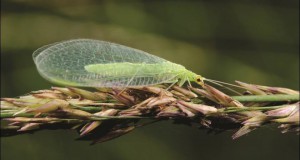
This guide provides assistance in selecting, purchasing, and using commercially available natural enemies and biopesticides for managing pest problems. The guide assists in the identification of pests by habitat and lists types of natural enemies (parasitic nematodes, predatory mites, predatory insects, and parasitic wasps) and biopesticides available to manage these pests. Scientific and product names are provided both for insect and mite natural enemies and for some of the most common microbial insecticides, nematicides, and fungicides that can be used to manage pests. Biological control companies are listed along with their websites, and the guide provides additional sources of information on obtaining and using commercial natural enemies. Written by Lynn M. LeBeck and Norman C. Leppla, and published by the UF Department of Entomology and Nematology, October 2015.
http://edis.ifas.ufl.edu/in849
Avian Diseases Transmissible to Humans
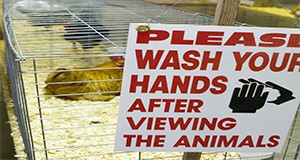 Anyone who keeps birds, whether as pets or as production animals, should be aware that certain avian diseases can be transmitted to humans. The seriousness of the disease in humans varies with human hosts’ age, overall health, and immune status as well as virulence of the organism, infective dose, and route of infection. This 4-page fact sheet is a major revision which discusses causes and symptoms of avian influenza (bird flu), chlamydiosis, salmonellosis, colibacillosis, encephalitis viruses, avian tuberculosis, Newcastle Disease, and cryptosporidiosis. Written by Michael A. Davis, Gary D. Butcher, and F. Ben Mather, and published by the UF Department of Animal Sciences, revised August 2015. Original publication date: August 1997.
Anyone who keeps birds, whether as pets or as production animals, should be aware that certain avian diseases can be transmitted to humans. The seriousness of the disease in humans varies with human hosts’ age, overall health, and immune status as well as virulence of the organism, infective dose, and route of infection. This 4-page fact sheet is a major revision which discusses causes and symptoms of avian influenza (bird flu), chlamydiosis, salmonellosis, colibacillosis, encephalitis viruses, avian tuberculosis, Newcastle Disease, and cryptosporidiosis. Written by Michael A. Davis, Gary D. Butcher, and F. Ben Mather, and published by the UF Department of Animal Sciences, revised August 2015. Original publication date: August 1997.
http://edis.ifas.ufl.edu/ps019
Maximizing Weed Control in Florida Citrus
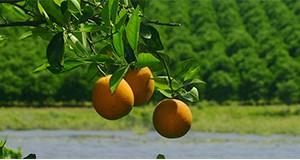
With Florida citrus growers and production managers being “squeezed” between rising production prices and declining yields from citrus greening, there’s more call than ever to reduce citrus production costs. Controlling weeds is a major expense, amounting to 11% of the total $2,278 annual production cost per acre for the 2014–2015 season. This 3-page fact sheet teaches the six essential components of an effective weed-management program to help maintain the profitability of this vital Florida industry. Written by Stephen H. Futch and Brent Sellers and published by the Horticultural Sciences Department. http://edis.ifas.ufl.edu/hs237
Mechanical Pruning of Citrus Trees
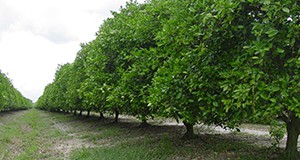
When citrus trees are not regularly pruned, less sunlight reaches the lower parts of the trees, which can reduce flowering and fruit development, quality, and color. Less sunlight also increases the risk of fungal infection. This 3-page fact sheets explains how growers can prune trees to maximize light exposure. Written by Mongi Zekri, and published by the UF Department of Horticultural Sciences, August 2015.
http://edis.ifas.ufl.edu/hs1267
Small Flock Poultry Nutrition
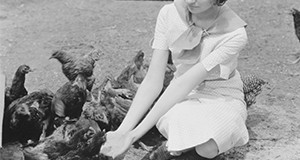
Inadequate poultry nutrition results in substandard growth rates as well as decreased egg production and weight. In order to express the genetic potential for which they were selected, meat- and egg-type birds must receive the correct amounts of nutrients and energy through properly formulated rations. This 4-page fact sheet examines the roles of water, carbohydrates, proteins and amino acids, lipids (fats and oils), vitamins, minerals, and feed additives in poultry growth and development. It also emphasizes the importance of providing suitable feeds to birds of different ages and discusses common feeding mistakes. Written by Michael A. Davis, published by the UF Department of Animal Sciences, and reviewed and revised August 2015. This fact sheet is a major revision of “Small Poultry Flock Nutrition,” written by B. L. Damron and D. R. Sloan, April 1998.
http://edis.ifas.ufl.edu/ps033
Understanding Nitrogen Transformations and Cycling for Sweet Corn Production in Sandy Soils
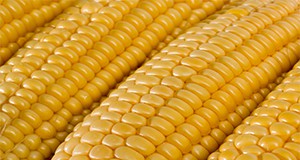 Because sandy soils have low water and nutrient-holding capacities and Florida experiences high rainfall periodically, optimizing fertilizer use efficiency for sweet corn production is challenging. The preparation of nitrogen budgets and the implementation of effective management strategies can help farmers overcome these obstacles. This 4-page fact sheet discusses major concerns which call for nitrogen management in sweet corn production, nitrogen budget preparation and interpretation, and important differences between farm-gate and soil system budgets. Written by Rishi Prasad and George Hochmuth, and published by the UF Department of Soil and Water Science, May 2015.
Because sandy soils have low water and nutrient-holding capacities and Florida experiences high rainfall periodically, optimizing fertilizer use efficiency for sweet corn production is challenging. The preparation of nitrogen budgets and the implementation of effective management strategies can help farmers overcome these obstacles. This 4-page fact sheet discusses major concerns which call for nitrogen management in sweet corn production, nitrogen budget preparation and interpretation, and important differences between farm-gate and soil system budgets. Written by Rishi Prasad and George Hochmuth, and published by the UF Department of Soil and Water Science, May 2015.
http://edis.ifas.ufl.edu/ss643
Creeping Indigo, A Poisonous Plant of Concern in Florida Pastures
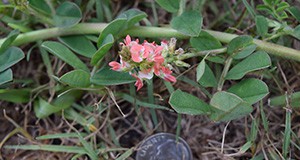 A recent rise in suspected horse poisonings has brought new attention to creeping indigo (Indigofera spicata), a toxic plant which has reportedly been in Florida for as long as 90 years. This new 5-page fact sheet covers plant description, signs of creeping indigo toxicity, and roles of creeping indigo’s toxins, as well as treatment and management. Written by Robert MacKay, Ed Jennings, Brent Sellers, Jason Ferrell, and Amanda House, and published by the UF Department of Agronomy, August 2015.
A recent rise in suspected horse poisonings has brought new attention to creeping indigo (Indigofera spicata), a toxic plant which has reportedly been in Florida for as long as 90 years. This new 5-page fact sheet covers plant description, signs of creeping indigo toxicity, and roles of creeping indigo’s toxins, as well as treatment and management. Written by Robert MacKay, Ed Jennings, Brent Sellers, Jason Ferrell, and Amanda House, and published by the UF Department of Agronomy, August 2015.
http://edis.ifas.ufl.edu/ag399
Flatwoods Citrus Best Management Practice: Riser-Board Structures
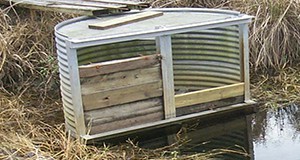 Water discharge structures are used to control water table levels and surface water levels in drainage and irrigation ditches within flatwoods citrus groves. The type of structure selected can significantly influence the quality of water discharged. With flashboard risers, water is forced to flow over the top board. This flow path creates a low current area toward the bottom, which facilitates the deposition of sediments and their accompanying nutrients or pesticides, essentially removing them from the discharges. Conversely, screw-gate structures do not create this dead-current zone. Since they open from the bottom, sediments are swept out along with the discharge water. Written by Chris Wilson, Liberta Scotto, Brian Boman, and Tim Gaver. Original publication date February 2002. Revised April 2012 and August 2015.
Water discharge structures are used to control water table levels and surface water levels in drainage and irrigation ditches within flatwoods citrus groves. The type of structure selected can significantly influence the quality of water discharged. With flashboard risers, water is forced to flow over the top board. This flow path creates a low current area toward the bottom, which facilitates the deposition of sediments and their accompanying nutrients or pesticides, essentially removing them from the discharges. Conversely, screw-gate structures do not create this dead-current zone. Since they open from the bottom, sediments are swept out along with the discharge water. Written by Chris Wilson, Liberta Scotto, Brian Boman, and Tim Gaver. Original publication date February 2002. Revised April 2012 and August 2015.
https://edis.ifas.ufl.edu/ss409
Flatwoods Citrus Best Management Practice: Soil Stabilization
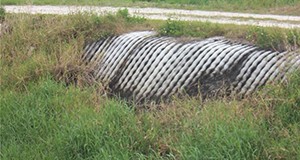
This best management practice describes stabilization practices for erosion-prone soils within flatwoods citrus groves. Significant amounts of soil may be deposited in drainage ditches and canals because of the erosion of grove soils. These deposited soils reduce the capacity for holding and transporting water. Plus, very small soil fractions may be suspended in discharge water then settle out in slower flowing areas and destroy submerged aquatic habitats, resulting in the loss of fish, invertebrate, and plant species important for healthy ecosystems. Fortunately, a variety of slope stabilization methods are available. This publication describes considerations for using plants for stabilization, or mulch-like materials. Written by P. Chris Wilson, Liberta Scotto, Brian Boman, and Tim Gaver. Original publication date March 2002. Revised April 2012 and August 2014. Reviewed August 2015.
http://edis.ifas.ufl.edu/ss408
Implications of Cow Body Condition Score on Productivity
Body condition score (BCS) indicates how much fat a cow has on its body, which is an important factor in cow health and reproductive capacity. Growers can use BCS to understand and manage the health of a herd and maintain a profitable operation. This 6-page fact sheet explains how BCS is measured, what different scores mean, the economic impact of various scores, and how changing cow nutrition can move BCS in a desired direction. Written by Matt Hersom, Todd Thrift, and Joel Yelich, and published by the UF Department of Animal Sciences, September 2015.
http://edis.ifas.ufl.edu/an319
Resetting in Citrus Groves
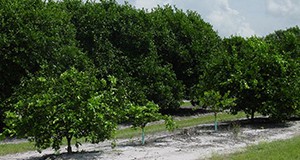
To maintain the overall productivity of a citrus grove, dead or declining trees should be promptly removed and replaced with young, healthy trees, a practice known as resetting. Resetting presents many challenges for growers because young trees require more attention and care than more established trees. This 4-page fact sheet discusses effective resetting methods and maintenance for citrus. Written by Zekri Mongi, and published by the UF Department of Horticultural Sciences, August 2015.
http://edis.ifas.ufl.edu/hs1266
Some Common Diseases of Pepper in Florida
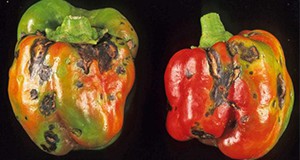
Pepper is an important commercial vegetable crop in Florida. During the months of November through May, the country is dependent on Florida for its supply of domestic fresh peppers. But disease problems often limit Florida pepper production. This fact sheet describes the symptoms and provides control recommendations for bacterial spot, phytophthora blight, wet rot, cercospora leaf spot, southern blight, blossom end rot, tobacco mosaic virus, aphid-transmitted viruses, and tomato spotted wilt virus (TSWV). Written by Gary Vallad, Pamela Roberts, Ken Pernezny, and Tom Kucharek. Originally published by the UF Department of Plant Pathology in March 1991, Revised September 2015. (Photo credit: Gerald Holmes, Bugwood.org, CC BY-NC 3.0 US). We would like to extend special thanks to professors emeriti Ken Pernezny and Tom Kucharek for interrupting their shuffleboard schedules to contribute to the revision of this publication.
http://edis.ifas.ufl.edu/vh054
“Candidatus Liberibacter solanacearum”: An Emerging Pathogen Infecting Potato and Tomato

A bacterium called “Candidatus Liberibacter solanacearum” infects potatoes and tomatoes, causing zebra chip in potatoes and psyllid yellows in tomatoes. These disease are highly destructive and have been known to reduce yields by up to 85%. “Ca. L. solanacearum” has been reported in several states, though it has not been detected in Florida, which is the second largest producer of tomatoes and seventh largest producer of potatoes in the US. This 9-page fact sheet covers the biology, distribution, symptoms, transmission, diagnosis, and management of the pathogen and its associated diseases. Written by Binoy Babu, Mathews L. Paret, Nicholas Dufault, and Carrie L. Harmon, and published by the UF Department of Plant Pathology, August 2015.
http://edis.ifas.ufl.edu/pp320
Implants for Cow-Calf and Stocker Beef Cattle

Getting cattle to put on a lot of muscle quickly is a crucial part of a beef cattle operation’s profitability. Growth promoting implants are one of the most cost-effective ways of increasing lean tissue in cattle and work by releasing hormones into the cow’s body that encourage muscle growth. This 4-page fact sheet explains implants’ mechanisms of action, how implants are administered and used, and concerns associated with implants. Written by Matt Hersom and Todd Thrift, and published by the UF Department of Animal Sciences, August 2015.
http://edis.ifas.ufl.edu/an318
Value-Added Products for Fresh Highbush Blueberries
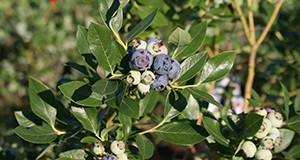
Blueberries are one of the most popular fruits worldwide. Blueberries’ health benefits have fueled this popularity, and today, blueberries can be found in products ranging from nutritional supplements to pet food. This 4-page fact sheet covers the processing methods such as freezing or drying that transform fresh blueberries into ingredients that can be used in other products. Written by Ruiqi Li and Liwei Gu, and published by the UF Food Science and Human Nutrition Department, June 2015.
http://edis.ifas.ufl.edu/fs268
How to Perform a Fetotomy in Cattle: An Illustrated Guide
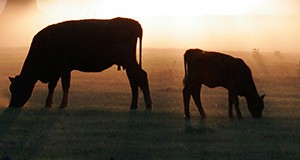 To perform a fetotomy means to dissect (to cut apart) a dead fetus in utero. Fetotomy is applicable particularly to cows because of the size of the uterus and the opportunity to introduce instruments to the full depth of the fetus. Fetotomy is an obstetric procedure that should only be performed by a trained veterinarian or under a trained veterinarian’s supervision. This 4-page fact sheet lists the circumstances when a fetotomy can be performed to save the life of the dam, the tools needed, fetotome preparation, the sequence of cuts for anterior presentation, and final comments. Written by Myriam Jimenez, Carlos Risco, and Klibs N. Galvão, and published by the UF Department of Veterinary Medicine-Large Animal Clinical Sciences, August 2015.
To perform a fetotomy means to dissect (to cut apart) a dead fetus in utero. Fetotomy is applicable particularly to cows because of the size of the uterus and the opportunity to introduce instruments to the full depth of the fetus. Fetotomy is an obstetric procedure that should only be performed by a trained veterinarian or under a trained veterinarian’s supervision. This 4-page fact sheet lists the circumstances when a fetotomy can be performed to save the life of the dam, the tools needed, fetotome preparation, the sequence of cuts for anterior presentation, and final comments. Written by Myriam Jimenez, Carlos Risco, and Klibs N. Galvão, and published by the UF Department of Veterinary Medicine-Large Animal Clinical Sciences, August 2015.
http://edis.ifas.ufl.edu/vm224
